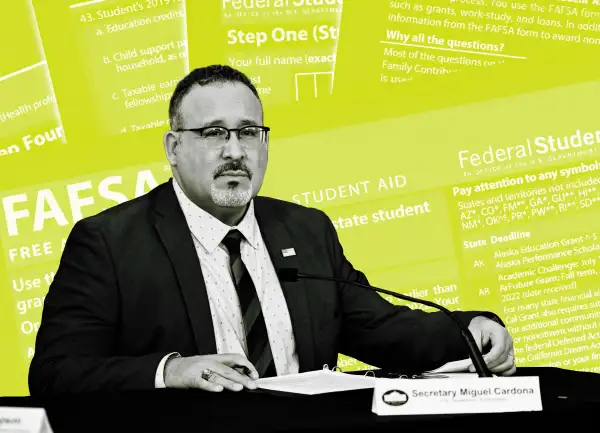FAFSA 'Crisis' Continues With Delayed Financial Aid Letters, Fewer Students Applying

Technical glitches, delays and communication failures continue to plague the process of applying for college financial aid this year.
The redesigned FAFSA, or Free Application for Federal Student Aid, was supposed to be a boon for college-bound students, thanks to fewer questions, a simpler form and a new formula for awarding aid. Instead, a laundry list of issues, including a murky release timeline last fall and multiple data problems this spring, has wreaked havoc on college admissions, frustrating families and financial aid offices alike.
"This really adds up to a crisis of credibility for the Department of Education," Justin Draeger, president and CEO of the National Association of Student Financial Aid Administrators, said Wednesday during a House subcommittee hearing. "We are in an awful place today," he later added.
In a typical year, most students applying to a four-year college would have financial aid letters in hand by now, detailing what kinds of grants or scholarships they qualify for and how much they have to pay out of pocket (or with student loans) to attend a particular school. This spring, though, many are empty-handed as financial aid officers scramble to condense months' worth of work into weeks after repeated delays and Education Department errors.
At a separate congressional hearing Wednesday, Secretary of Education Miguel Cardona assured lawmakers that resolving FAFSA issues was the top priority for the department right now.
"We're working on this around the clock," he said.
FAFSA completion rates are down by 40%
The FAFSA redesign has been a long time coming. First approved in 2020, college access advocates hoped that a simpler process for applying for financial aid would improve what's been a notorious headache for families in the past. The idea was that if the FAFSA was easier to complete, more people would do it, and in turn, more students would be able access the grants and scholarships they need to afford higher education and ultimately enroll.
But this year's bungled rollout seems to be having the opposite effect.
The number of high school seniors who have completed a FAFSA is down 40% from last year, according to the National College Access Network (NCAN). Part of the problem is that students with mistakes on their application haven't been able to correct those yet this year because the technology isn't ready, so they haven't been able to finish them. As many as 16% of students need to make FAFSA corrections when that capability launches, which the department says should be next week.
Yet even after adjusting for forms that need corrections before they're moved into the completions tally, an alarming gap remains. To match last year's final filing rate, more than 1 million applications are still needed from high school seniors this year.
Bill DeBaun, senior director of data and strategic initiatives at NCAN, tells Money he suspects the main driver of the discrepancy is timing. The FAFSA launch this year was delayed from October to January, which meant seniors had nearly 100 fewer days to get support and fill it out.
"We're running out of road," DeBaun says, adding that while students are technically able to fill out the form over the summer, many will lose access to teachers and counselors who can help when school lets out.
While FAFSA completion rates are down across the country, the effects are more pronounced in some areas. High schools with larger shares of low-income and minority students are faring worse than their peers: California, Tennessee, Alabama and Mississippi have some of the biggest year-over-year drops in the number of seniors that have finished the FAFSA.
In California, in particular, many immigrant families struggled to access the application because of a glitch that didn't allow parents without Social Security numbers to fill out the form. (Students who aren't U.S. citizens cannot use federal financial aid, but a parent's citizenship has no bearing on their child's eligibility.)
It's hard to predict what may happen next fall, but the outlook now is grim. Research has shown that seniors who complete a FAFSA are far more likely to enroll immediately in college. DeBaun says, therefore, it's not out of the question that the nation may see a 4% to 5% drop in enrollment.
Most students still waiting on financial aid letters
Many colleges still haven’t been able to send out financial aid letters to accepted students, leaving families in a state of limbo.
That’s partially due to the sheer volume of student records colleges have received in recent weeks. Usually, colleges get information on a rolling basis as students complete the financial aid form. But this year, the Education Department didn't begin sending student files until two and a half months after the application opened — in effect, staffers received a collective 7 million FAFSAs in a small window instead of spread out over time.
Hence the administrative crunch.
Another part of the blame lies with still-unresolved data problems with many applications. Last week, the department announced nearly 20%, or about 1 million, forms it had processed so far this year had “inconsistent” tax information from the IRS. In a separate incident announced in late March, the government miscalculated aid eligibility for about 200,000 dependent students who reported assets on their form.
All in, the Education Department says about 30% of FAFSA forms filed so far may be affected by processing or data errors. At some colleges, though, the share may be even higher.
Rachelle Feldman, vice provost for enrollment at the University of North Carolina at Chapel Hill, told lawmakers Wednesday that the university had received just 60% of the records it usually has by this time of the year. What's more, 48% of the student records the university does have on file were flagged for reprocessing because of data or calculation errors.
“We feel like we’re flying blind without a clear path, and we have yet to release a single aid offer,” she said. That's massive for a top-ranked college that admits more than 9,000 freshmen per year.
Sixteen percent of colleges said in a poll this week that they'd already sent out financial aid packages to students. But about 20% of colleges said they only plan to send offers to students who aren't affected by data issues before May 1, while 14% said they don't anticipate being able to send out any award letters before next month.
Schools are pushing back commitment deadlines
As the issues keep coming, hundreds of schools have pushed back the typical admissions timeline.
In a normal year, students applying during the regular admissions cycle would receive their financial aid offers around the time they receive acceptance letters. Then, they’d have at least a month — but often more — to run the numbers and make a decision about whether to enroll at a specific college.
This time period is crucial for a lot of families. In many cases, it's the first time they have reliable, individualized information about how much a college will actually cost to attend, and they’re sometimes comparing aid offers from more than one school to see which is most affordable.
After issuing financial aid letters, colleges often have a May 1 deadline in which they ask applicants to respond to an offer of admission. So far this year, more than 260 colleges, or about 55% of institutions, have moved that deadline back, according to a list from the National Association for College Admission Counseling. The majority of those colleges bumped back the date to June 1, but some have due dates as late as August. (Another 16% of colleges have not officially changed their deadline, but said they’re offering extensions on a case-by-case basis.)
The problem is students may have acceptances from colleges that have different deadlines, says Shannon Vasconcelos, senior director of college finance for Bright Horizons. That complicates things for families who are weighing whether to put down a deposit at a school that has kept its May 1 deadline when they're still waiting to hear about financial aid from other colleges.
It's bad enough that students still haven't gotten solid answers about financial aid, she says. But now that they have to navigate inconsistent deposit deadlines, "it's just adding this new stress and pressure on families."
More from Money:
4 Things Families Get Wrong About College Costs
Biden's New Student Loan Forgiveness Plan Could Cancel Debt for 30 Million






